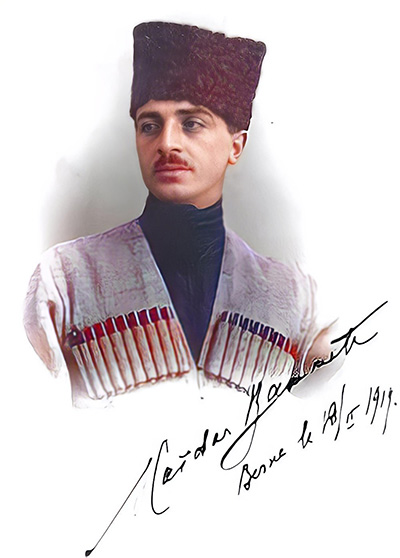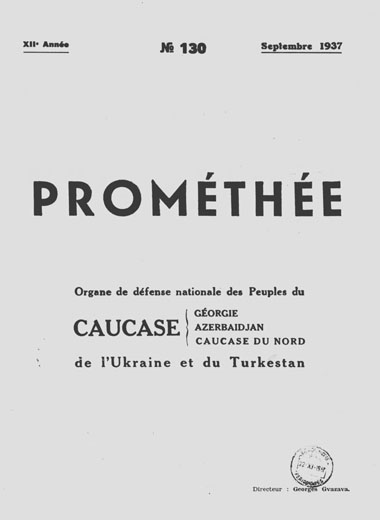
Haydar Bammat is known as one of the most highly qualified intellectuals of the North Caucasus. Involved in revolutionary activities since 1910, when the Russian Empire started to be weakened, Bammat devoted his life to the struggle for the independence and statehood of the North Caucasus and the battle for the Confederative Union of the Caucasian Peoples. Because of his outstanding qualities, in 1920 one of the prominent French diplomats, Abel Chevalley referred to him as the Talleyrand of the Caucasus. After World War I, Bammat sought the support of Western powers for the independence of the North Caucasus through his diplomatic activities in Bern and Paris. Still, he was unsuccessful in this struggle due to the Paris Peace Talks that ended with shortsighted decisions. The efforts of Bammat, who later served as a member of the Union Council (Allied Madjlis) of the Caucasus Mountaineers in Tbilisi and elected as the chairman of provisional parliament in his absentia in Temirkhan-Shura, were not enough for the Allied powers to adequately understand the Bolshevik threat.

In October-November 1924, in Paris, after meetings with the representatives of Azerbaijan and Georgia Bammat succeeded in pursuing his interlocutors to decide to create a union of Azerbaijan, the North Caucasus, and Georgia in the form of a confederation. After a special commission was created to draft a constitution for the future confederation, a Caucasian Committee was formed to unite the diplomatic efforts of the Caucasian nations. Bammat was also one of the leaders who laid the foundation for Polish-Caucasian cooperation in the early 1920s and the Committee of Caucasian Confederalists was created in Istanbul which was included in the central Caucasian organ of the Prometheus movement and the Committee for the Independence of the Caucasus (KNK). The first issue of the Prometheus magazine, the periodical of the Committee for the Independence of the Caucasus, was compiled in Bammat’s Paris apartment. He was also the name father of the magazine. However, Bammat had written only one article in the Prometheus magazine as his relations with the Prometheus movement began to deteriorate due to the popülist and opportunistic tendencies of the Georgian Mensheviks and Azerbaijani Musavatists who started to support a fraction of Said Shamil among the North Caucasian Mountaineers against Haydar Bammat’s group named “KAVKAZ”. Under the influence of the Polish government, mainly the leaders of the Popular Party of the Caucasus Mountaineers started to seize the power in representation of the North Caucasian National groups in the Promethean Movement and the Caucasian Independence Committee. Bammat had the belief that these people had never played any significant role in the national liberation movement of the North Caucasus in 1918-20. On the contrary many of these people had absorbed critical roles in General Denikin’s invasion of the North Caucasus and they did not have the qualities to represent North Caucasian Mountaineers on the stage of political initiatives in immigration.


The magazine consisted of many articles devoted to criticism of the policies of the Menshevik government of Georgia in 1918-1921, which was held responsible for the missed opportunities to create a Caucasian Union, as a result of which the Bolsheviks were able to put an end to the independence of the North Caucasus, Azerbaijan, Armenia, and Georgia one after another. Similar to their Georgian colleagues in the Group Kavkaz, Azerbaijanis were also in irreconcilable opposition to the leader of the Musavat party Mehmed Emin Rasulzade, and his journal Kurtulush, which was published in Berlin due to the harsh criticisms published in “Kurtulush” against both Bammat himself and his Azerbaijani colleagues.
Bammat's closest associates among the North Caucasian émigré groups, Ossetian Muslims, Alikhan Kantemir and Tambiy Elekkhoti were targeted by their North and Trans-Caucasian political rivals by an accusation of spying for the Russian Bolsheviks. This conspiracy had fueled the fight between the two groups which led Bammat to write a letter to the Polish boss of the Prometheans, Tadeusz Holowko to stop intervening in the affairs of the Caucasians.
During the first stage between 1934-1936, the magazine "Kavkaz" was published only in Russian. Due to the clear symptoms of coming off another world war, Bammat started publishing the magazine in French, English, German, and Turkish languages for the quest to find the correct ally against the Russian communists if the expected war would break. The publication of the French version of "Caucasus" - "Le Caucase" was launched in Paris with a circulation of 700 copies. Since the beginning of 1938, the magazine "Caucasus" began to be published in English and German, under the names "Caucasian Quarterly" and "Der Kaukasus". Each of these publications was published with a circulation of 600 copies. The purpose of these magazines, published right up until the very end of the organization's existence, in August 1939, was to propagate the Caucasian issue in all countries that could potentially end up in the camp of the opponents of the Soviet Union. Each version of the magazine was adapted to the realities of the country in whose language it was published. During this period Bammat had suffered for the ban of the Turkish government against his publications. For that reason, the flagship publication “Kavkaz” started to be published also under the title “Zarya Kavkaza” to overcome the prohibition. Turkish government who wanted to avoid any trouble with the USSR, behaved reluctant towards Caucasian émigré groups. Against all odds, Bammat and his colleagues insisted on establishing friendly relations with the Turkish Republic. Although this approach was very hard to assimilate for the Georgian members of the group due to the territorial disputes with Turkey especially Zurab Avalishvili was convinced of the need to find grounds for agreements with the southern neighbors of the Caucasus, and also understanding the senselessness of putting forward territorial demands to Ankara and Tehran, devoted several articles to this issue. Avalishvili was a supporter of the principles of realpolitik, no matter how bitter it was. He tried to instill in the Caucasians the need to adapt to the harsh realities of the modern world, no matter how painfully they affected their historical memory. Trying, in a certain way, to "comfort" the Armenians and to attract them to pan-Caucasian cooperation, he wrote that the disappearance of Turkish Armenia was associated with the emergence of the Armenian diaspora in Europe and America. A special emphasis on the purely Caucasian character of Armenia, Georgia, and Azerbaijan was especially important since many emigrants subsequently reproached Avalishvili, and even more so Bammat himself, for "Turkophilia." The inconsistency of such an assertion becomes obvious already as a result of the fact that Azerbaijani Musavatists accused Avalishvili of "Turkophobia." In particular, in the fact that Avalishvili, who is generally unfriendly to Turkey, is allegedly trying to tear Caucasian Azerbaijan away not only from Iranian Azerbaijan but from the entire Turkic world as a whole. In this regard, Avalishvili emphasized that “…from the Caucasian point of view, it is very important to know how the national consciousness of Caucasian Azerbaijan will develop and evolve. “Kurtulush” apparently has little interest in the Caucasian character of the country: he has before his eyes Azerbaijan in the broad sense of the word, moreover, the entire Turkish world from the borders of China to the Mediterranean Sea.” This thesis of Bammat and Avalishvili, about the absolute necessity for the Caucasians to establish good relations with Turkey and Iran, was, in fact, confirmed by the rapidly developing events of international politics.
Bammat went to Berlin at the end of 1936 and discussed possible cooperation against the USSR with the Japanese and German circles. During these negotiations, it was agreed to publish the magazine “Kavkaz” also in the Turkish, Georgian, and Armenian languages. It should be noted here that in no article of the various versions of "Kavkaz" can one find any panegyrics to the ideology of German National Socialism. Following the ratification of the Soviet-German, Molotoff-Ribbentrop treaty in August 1939 the political climate in Germany dramatically changed against the Caucasian immigration. The Germans who did not want to lose the opportunity of a future alliance with the Caucasian groups in case of a war against the Soviets asked Haydar Bammat to stop his activities in Germany, leave the German territory, but be in close and continuous contact with the Japanese. The developments in political fields and war led Bammat to attend the famous Adloniade meetings in Berlin in 1942 which was going to be a determiner also for his future publication activities. However, Bammat who was not content with the attitude of German National Socialists broke the ties with them completely and lived in Switzerland until the end of the war. During the wartime period, he wrote articles in magazines like “Le Mois Suisse” with the pseudonym Georges Rivoire. After the war, Bammat left all publication affairs to the responsibility of his close ally Alikhan Kantemir and devoted himself to the rehabilitation of Caucasian victims of WW2 and Islamic studies.
On this occasion, I am pleased to share with you 136 issues of the periodicals published by Haydar Bammat and his group between 1934 and 1939, which occupy a very important place in the history of the early 20th-century Caucasus.
Please click on the link below to access the publications (subscription is free of charge):
https://www.historycaucasus.com/archives?category=3&publisher=Group%20Kavkaz&page=1
1934-39, Kavkaz (Russian), 66 issues
1934, Kafkasya (Turkish), 1 issue
1936-39, Zarya Kavkaza (Russian), 31 issues
1936-37, Kafkas Almanağı (Turkish), 2 issues
1937-38, Kafdağı (Turkish), 2 issues
1937-39, Revue Mensuelle Le Caucase (French), 25 issues
1937-39, The Caucasian Quarterly (English), 4 issues
1938, Der Kaukasus (German), 2nd issue
1939, Revue Mensuelle L'indépendance Caucasienne (French), 3 issues
1939, Kafkas Eli (Turkish), 1 issue
Cem Kumuk
İstanbul, 12 October 2024
